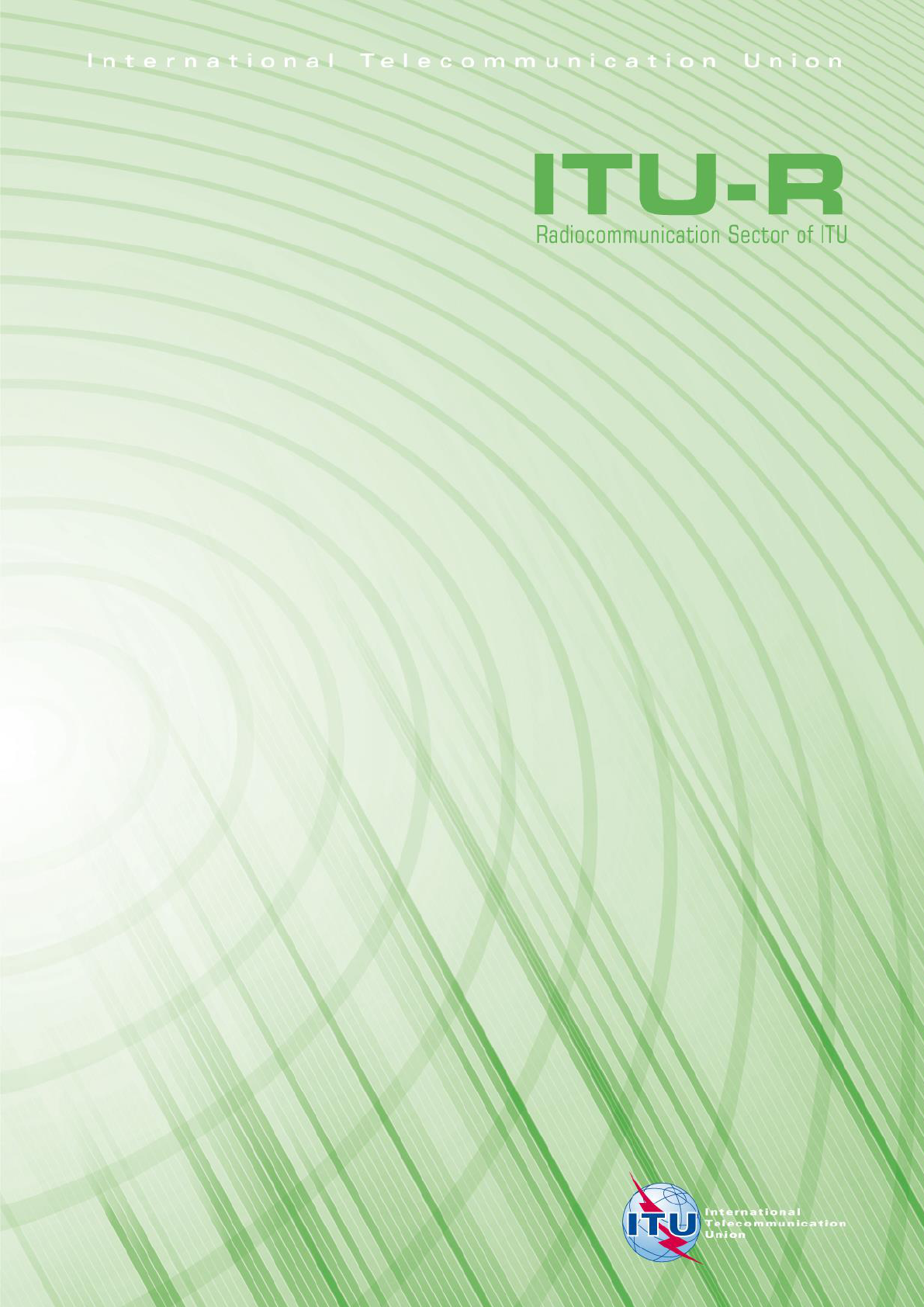
Report ITU-R BT.2207-6
(09/2022)
Accessibility to broadcasting services
for persons with disabilities
BT Series
Broadcasting service
(television)
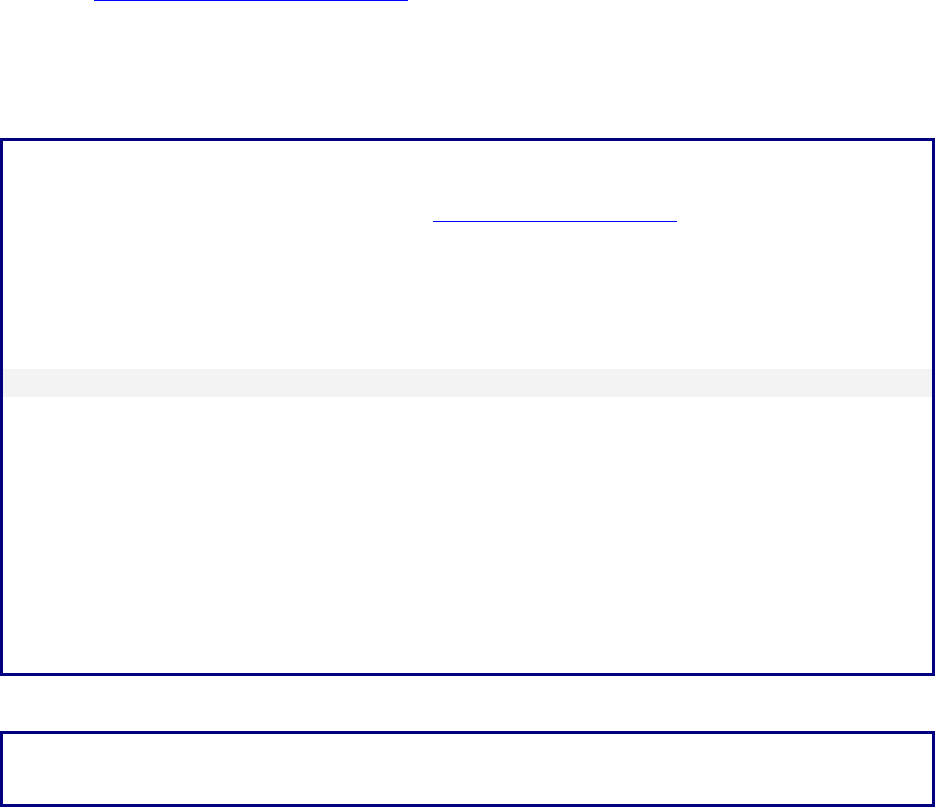
ii Rep. ITU-R BT.2207-6
Foreword
The role of the Radiocommunication Sector is to ensure the rational, equitable, efficient and economical use of the radio-
frequency spectrum by all radiocommunication services, including satellite services, and carry out studies without limit
of frequency range on the basis of which Recommendations are adopted.
The regulatory and policy functions of the Radiocommunication Sector are performed by World and Regional
Radiocommunication Conferences and Radiocommunication Assemblies supported by Study Groups.
Policy on Intellectual Property Right (IPR)
ITU-R policy on IPR is described in the Common Patent Policy for ITU-T/ITU-R/ISO/IEC referenced in Resolution
ITU-R 1. Forms to be used for the submission of patent statements and licensing declarations by patent holders are
available from http://www.itu.int/ITU-R/go/patents/en where the Guidelines for Implementation of the Common Patent
Policy for ITU-T/ITU-R/ISO/IEC and the ITU-R patent information database can also be found.
Series of ITU-R Reports
(Also available online at http://www.itu.int/publ/R-REP/en)
Series
Title
BO
Satellite delivery
BR
Recording for production, archival and play-out; film for television
BS
Broadcasting service (sound)
BT
Broadcasting service (television)
F
Fixed service
M
Mobile, radiodetermination, amateur and related satellite services
P
Radiowave propagation
RA
Radio astronomy
RS
Remote sensing systems
S
Fixed-satellite service
SA
Space applications and meteorology
SF
Frequency sharing and coordination between fixed-satellite and fixed service systems
SM
Spectrum management
Note: This ITU-R Report was approved in English by the Study Group under the procedure detailed in
Resolution ITU-R 1.
Electronic Publication
Geneva, 2022
© ITU 2022
All rights reserved. No part of this publication may be reproduced, by any means whatsoever, without written permission of ITU.
Rep. ITU-R BT.2207-6 1
REPORT ITU-R BT.2207-6
Accessibility to broadcasting services for persons with disabilities
(2010-2011-2012-2017-2018-2020-2022)
TABLE OF CONTENTS
Page
1 Hearing disabilities ......................................................................................................... 3
2 Sight impairment ............................................................................................................ 3
3 Aging audience ............................................................................................................... 3
4 Receiver user-friendliness .............................................................................................. 4
Annex 1 – Technologies to improve accessibility to broadcasting services ............................ 4
1 Speech rate conversion technology ................................................................................ 4
2 Real-time closed-captioning using speech recognition .................................................. 7
3 Multimedia browsing system for the visually impaired ................................................. 10
4 Machine translation to sign language with CG-animation ............................................. 12
5 Device for evaluating broadcast background sound balance .......................................... 15
6 Easy-to-read language broadcasting service and language conversion support technology... 16
6.1 What does easy Japanese mean? ......................................................................... 17
6.2 Web service functions ......................................................................................... 18
6.3 Rewrite support system ....................................................................................... 19
6.4 Future challenges ................................................................................................ 20
7 Sound level adjustment system with a speech rate conversion (SRC) for channel-based
stereo signals .................................................................................................................. 20
7.1 Prototype speech rate conversion system ........................................................... 20
7.2 Subjective evaluation .......................................................................................... 22
8 Personalization that improves accessibility using object-based sound technology ........ 23
8.1 Dialogue enhancement ........................................................................................ 23
8.2 Audio description and multilingual dialogues .................................................... 23
9 Haptic information presentation technology .................................................................. 23
10 Audio descriptions .......................................................................................................... 24
10.1 Audio Descriptions, example for Live Broadcasts ............................................. 24
Annex 2 – Terminology and guidance for operational practice related to audio-visual media
accessibility .................................................................................................................... 28
2 Rep. ITU-R BT.2207-6
Foreword
There are 650 million people with disabilities in the world today – about 10% of the world’s
population – and their proportion and number are growing, as humanity lives longer.
A disproportionately high number of those with disabilities are in developing countries. Television,
radio, and Internet are an integral part of the fabric of society, and we cannot imagine a “full life’
without them. Having a disability can deny normal access to the media, and this can limit life-choices,
personal independence, personal fulfilment, sense of identity, enjoyment, and social cohesion.
In considering Resolution 70 (Johannesburg, 2008) of the World Telecommunication Standardization
Assembly as well as Resolution 58 (Hyderabad, 2010) of the World Telecommunication
Development Conference, on access to ICT for persons with disabilities, including age-related
disabilities, the ITU Plenipotentiary Conference (Guadalajara, 2010) approved Resolution 175 that
instructs all three ITU sectors, inter alia, “to take account of persons with disabilities in the work of
ITU, and to collaborate in adopting a comprehensive action plan in order to extend access to
telecommunications/ICTs to persons with disabilities, in collaboration with external entities and
bodies concerned with this subject”.
The following is given in the UN Convention as an explanation of the principle of “disability”.
“Persons with disabilities include those who have long-term physical, mental, intellectual or sensory
impairments which, in interaction with various barriers, may hinder their full and effective
participation in society on an equal basis with others”.
Particularly important disabilities relevant for the media include:
– hearing disabilities;
– seeing disabilities;
– aging disabilities;
– cognitive disabilities;
– lack of controllability of the man-machine interface and ease of use of the receiver or
terminal.
However, the structure of the broadcasting system, language/writing system and culture, broadcast
formats vary from one country to another and affect what kind of services may be delivered.
The Convention does not ask that infinite resources be given over to providing services for those with
disabilities, but it does call for “reasonable accommodation” for persons with disabilities.
The interpretation of this is clearly a critical issue that needs much care.
The Convention offers the following explanation of reasonable accommodation: “necessary and
appropriate modification and adjustments not imposing a disproportionate or undue burden, where
needed in a particular case, to ensure to persons with disabilities the enjoyment or exercise on an
equal basis with others of all human rights and fundamental freedoms”.
So, what is a proportionate burden on television, radio, and Internet to provide measures that will
make it possible for those with hearing, sight, or aging disabilities to consume the same services as
those without disabilities? In other words: What is “reasonable”?
Each country should establish its own accessibility programmes in response to the wishes of its
population with disabilities, broadcast standards, technical possibilities, resources available for
investment and the management circumstances of its broadcasters.
The ITU-R may have a role to play in promoting the technical research and development that will
make it possible to provide such accessible services and that will ease the burden of doing so on
broadcasters, and/or in defining necessary conditions and specifications for broadcasting systems and
accessible receivers. The ITU-R also has a role to play in establishing a system for sharing worldwide
Rep. ITU-R BT.2207-6 3
the results of research and development along with information and know-how on the practical
operation of accessible services.
What kind of accessible broadcast services may be introduced on what timescale depends on local
conditions in each country as discussed above; the following sections are intended as examples of the
kind of technology that may contribute to accessible services depending on local conditions.
1 Hearing disabilities
For television viewing, the main method of making programmes accessible is by providing optional
subtitles.
Hearing impaired people prefer television programmes, broadcast, streamed, or downloaded which
include optional subtitles in the language of the intended audience. Digital television systems have
made it possible for the subtitles to be cut into the picture by a simple procedure on the remote control.
For television viewing, the secondary method of making programmes accessible is by having a Signer
“in screen” providing a sign language version of the audio. This can be included permanently in the
picture, or it may in the future be possible optionally cut into the picture, at the user’s choice, using a
broadcast multimedia system.
For radio listening, the main method of making programmes accessible is by providing data that
allows display of speech on a receiver screen (speech-to-text conversion data).
Digital radio (audio) programmes, broadcast, streamed, or downloaded, can now include data for
speech-to-text display in the receiver. A text display may also be helpful for hearing impaired people
to understand the radio programme.
2 Sight impairment
For television viewing, the main method of making programmes accessible to those with sight
impairment is to use “audio descriptions”. These are audio passages that explain what is happening
visually in the picture. They are provided on a second audio channel, which is mixed in the receiver
with the normal audio in natural pauses in dialogue. Audio descriptions are particularly effective with
drama.
Audio descriptions can also be helpful to those with aging disabilities to bring to their attention things
they need to notice in the picture to follow the plot fully.
3 Aging audience
Aging audience can experience difficulties when trying to follow the dialogue on the radio or on
television because it appears to flow too quickly. The main method of making radio programmes
accessible is to adjust electronically the natural silence periods in the dialogue, and thus to make the
dialogue appear to be slower.
It is known that through the aging process, response time tends to slow down. It can be valuable to
add “audio descriptions” to television programmes in the pauses in dialogue, which help the viewer
to follow the story line (e.g. a voice says, “Notice the clock on the wall is at five o’clock”).
Radio programmes available via Internet with several speed adjustment options may help a wider age
range of listeners to understand the programmes.
4 Rep. ITU-R BT.2207-6
4 Receiver user-friendliness
Receivers should be available which have users with disabilities in mind. This can be done by the
inclusion of facilities that include:
– simple and self-evident controls, which operate in a similar way on all receivers;
– visual and audio guides to programme selection and choice;
– facilities for subtitle display, signer display, and audio descriptions.
It is important to note that the practicality of such features varies according to the local broadcasting
system and formats, and obviously requires the cooperation of receiver manufacturers.
Annex 1 is a report on the latest studies on technologies to improve accessibility to broadcasting
services. There has been a growing interest in “universal-design products” that anyone can use with
ease. Moreover, with the coming of the aging society, there will be an increasing need to develop
products and services while having a good understanding of the physical characteristics of people
with disabilities. The radio and television – the information devices most familiar to everyone – have
become an indispensable part of daily life. A pressing issue here is how to convey broadcast
information to people with disabilities. Achieving universal design in broadcasting will require a
comprehensive study that examines programme production techniques at the broadcasting station
while also considering the ease of operating receivers, a fitting function for making viewing and
listening easy for each user, etc.
Annex 2 details references to three ISO/IEC documents that are relevant to accessibility to
broadcasting services for persons with disabilities:
– Guidance on audio descriptions (ISO/IEC TS 20071-21:2015, Information technology - User
interface component accessibility – Part 21)
– Visual presentation of audio information, including captions and subtitles (ISO/IEC
20071-23:2018, Information technology – User Interface component accessibility – Part 23)
– Guidance on the audio presentation of text in videos, including captions, subtitles and other
on-screen text (ISO/IEC TS 20071-25:2017, Information Technology – User interface
component.
Annex 1
Technologies to improve accessibility to broadcasting services
1 Speech rate conversion technology
As the average age of the television audience increases, broadcaster often receive comments that
speech in contemporary broadcasts is too fast for comfortable listening. Although the use of hearing
aids could be considered as one way of compensating for hearing difficulties when listening to radio
or TV programmes, this would not be effective for all hearing difficulties especially age related
hearing loss. At present, no hearing aid can effectively compensate rapid speech. The development
of technologies that can assist a wide age range audience to listening to radio or television broadcasts
is needed [1].
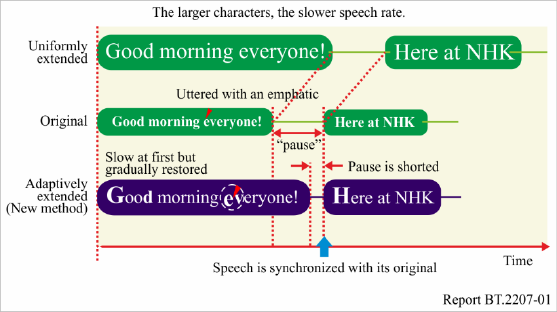
Rep. ITU-R BT.2207-6 5
The adaptive speech rate conversion function plays speech more slowly without overrunning the
programme’s time slot while maintaining the quality of speech. Since a time delay would be
accumulated if waveform expansion were applied evenly across speech, this technology effectively
shortens non-voice intervals (that is, pauses consisting of breaths or portions with only noise). It also
speeds up or slows down the rate of speech delivery to model actual utterances. Time delay is
gradually eliminated while maintaining a sense of slower speech [1], [4].
Slowing down the speech rate without accumulating a time delay requires an appropriate balance
between contracting non-voice intervals and expanding voice intervals. Previous research
investigating the relationship between a “sense of slowness” and “naturalness” reported that
expanding voice intervals as much as possible was effective as long as the length of non-voice
intervals was maintained at a point that minimally satisfies the need for naturalness. Such technology
should also be applicable to all broadcasts, including dramas and variety shows in addition to news
programmes and other content that consists mostly of speech. Consideration should therefore be given
to handling not just speech-based information but non-voice information as well. This can be done
by first observing pitch frequency (the basic frequency of speech) and calculating its signal-to-noise
(S/N) ratio with background sounds and then dynamically identifying voice and non-voice
information in the context of actual programme sounds.
A practical speech rate conversion algorithm for incorporation in a receiver should do the
following [3], [4]:
1) Use the S/N ratio to help identify voice intervals and non-voice intervals.
2) Allow non-voice intervals to be shortened while maintaining a time interval that does not
make speech sound unnatural to the listener and allocate that deleted portion to voiced
intervals.
3) Make the expansion of voice intervals variable (as opposed to uniform), placing an emphasis
on expanding those portions for which an improved sense of slowness can be expected.
4) To minimize time delay accumulation, immediately suspend processing for which signal
observation for longer than a certain amount of time would be required.
Based on this framework, NHK developed adaptive speech rate conversion technology as shown
in Fig. 1. Here, speech that can be uttered in one breath is used as a working unit. Converted speech
is then realigned with original, real-time speech after a relatively long pause (non-voice interval)
corresponding to the taking of a breath. This eliminates any accumulated time delay.
FIGURE 1
Outline of adaptive speech rate conversion technology
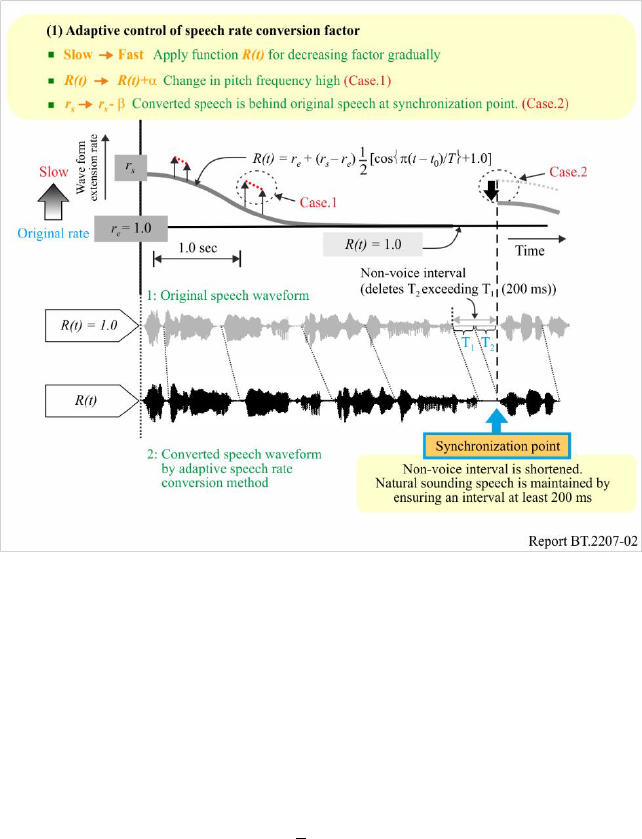
6 Rep. ITU-R BT.2207-6
For radio and television announcers, it is wrong to speak on air with a uniformly slow voice; the
correct way is to slow down at certain times as appropriate. In particular, a good rule of thumb is to
slow down at the beginning of an utterance or during portions uttered with an emphatic, as this tends
to make a good overall impression on listeners. It was therefore decided to make this rule of thumb
into an engineering model. Experiments showed that the converted speech in which the initial portion
was made slower was easier to listen to than the original speech of the same length [2].
The following describes the algorithm for adaptive speech rate conversion (see Fig. 2) [4].
FIGURE 2
Operation of adaptive speech rate conversion technology
1. In a typical intonation pattern uttered by an announcer, pitch frequency is highest in the initial
portion of the utterance and falls in a nearly monotonous manner towards the end of the
utterance. This gradual change is approximated by the monotonously decreasing function
described below. Speech rate is changed in pace with this change in pitch frequency.
2. Figure 2 shows the method used to gradually eliminate time delay with respect to original
speech. Given time period Lp (= 2.500 ms) as the average time taken to speak in one breath,
the speech rate is gradually changed over this period (up to T = Lp) according to the
monotonously decreasing function R(t).
(1)
Here, r
s
and r
e
are the speech rate conversion factors at the beginning and end portions,
respectively, of the utterance. Their initial values are r
s
= 1.3 and r
e
= 1.0. When pitch
frequency momentarily becomes higher, it is considered that there is some purpose behind
that action and the degree of slowness at that location is temporarily increased compared to
the speech rate before and after that point (Case 1).
3. If speech continues past Lp, speech rate conversion is generally not performed, but at t = Lp,
r
s
is reset if pitch frequency at that point in time is 70% or more of that at the beginning of
the utterance.
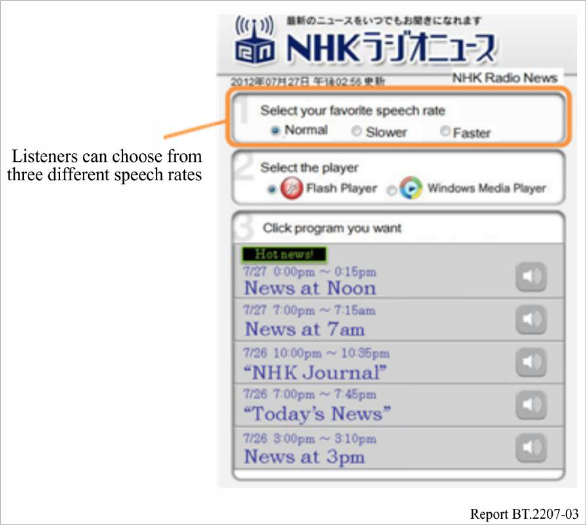
Rep. ITU-R BT.2207-6 7
4. If converted speech turns out to be longer than the corresponding original speech, the
subsequent non-voice interval (= T1+T2) is reduced to T1. At about 200 ms, T1 is the
minimum time interval for which speech still sounds natural. In this case, r
s
is temporarily
modified downward (Case 2).
This technique prevents accumulation of time delay and enables programmes to be enjoyed with
slower speech even for content accompanied by video images, as in TV.
This speech rate conversion technology was also implemented in the radio-on-demand services on
the website. Listeners can choose from three different speech rates: 1. normal, 2. slower, and 3. faster.
Normal is the original speed. Slower is 0.83 times the original speed. Faster is 1.7 times the original
speed by our proposed adaptive conversion method. Figure 3 shows a page from the NHK radio news
site, which is a service on the website.
FIGURE 3
Website service of radio news with speech rate conversion technology
2 Real-time closed-captioning using speech recognition
There is a great need for more TV programmes to be closed-captioned to help hearing impaired and
those with age-related hearing loss to enjoy TV programmes. Automatic speech recognition is useful
for producing text from speech in real-time. NHK has been using speech recognition for closed-
captioning of some of its news, sports, and other live TV programmes [5]. In news programmes,
automatic speech recognition applied to anchor’s speech in a studio has been used with a manual
error correction system [6]. Live TV programmes, such as music shows, baseball games, and soccer
games, have been closed-captioned by using a re-speak method in which another speaker listens to
the programme and rephrases it for speech recognition [7], [8].
Automatic speech recognition is a computer-based technique for creating text from speech. Speech
recognition has advanced a great deal thanks to statistical analysis and increased computing power.
Large-vocabulary continuous speech recognition can now be found in several applications, though it
does not yet work as well as human perception and its target domain in an application is still limited.
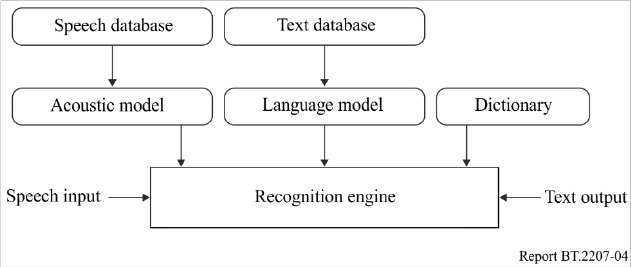
8 Rep. ITU-R BT.2207-6
Researchers have therefore focused on developing better speech recognizers and applying them to
closed-captions for TV programmes.
A speech recognizer typically consists of an acoustic model, a language model, a dictionary and a
recognition engine (Fig. 4). The acoustic model statistically represents the characteristics of human
voices; i.e. the spectra and lengths of vowels and consonants. It is trained beforehand with a database
of speech recorded from NHK broadcasts. The language model statistically represents the frequencies
of words and phrases used in the individual target domain; e.g. news, baseball or soccer. It is also
trained beforehand with a text database collected from manuscripts and transcriptions of previous
broadcasts. The dictionary provides phonetic pronunciation of the words in the language model.
Because the recognition engine searches for the word sequence that most closely matches the input
speech based on the models and the dictionary, it cannot recognize words not included in them.
Training databases are therefore important for obtaining satisfactory speech recognizer performance.
The notable features of NHK’s speech recognizer which make it suitable for real-time closed-
captioning are the speaker-independent acoustic model, the domain-specific language model, which
is adaptable to the latest news or training texts, and the very low latency [9] from the speech input to
the text output.
FIGURE 4
Automatic speech recognizer
The commentaries and conversations in live TV programmes such as sports are usually spontaneous
and emotional, and a number of speakers sometimes speak at the same time. If such utterances are
directly fed into a speech recognizer, its output will not be accurate enough for captioning because of
background noise, unspecified speakers or speaking styles that do not match the acoustic and
language models. It is difficult to collect enough training data (audio and text) in the same domain as
the target programme. Therefore, the re-speak mode is employed to eliminate such problems. In the
re-speak mode, a speaker different from the original speakers of the target programme carefully
rephrases what he or she hears. This person is called the “re-speaker”. The re-speaker listens to the
original soundtrack of live TV programmes through headphones and repeats the content, rephrasing
if necessary, so that the meaning will be clearer or more recognizable than the original (see Fig. 5).
This mode provides several advantages for speech recognition.
The progress made in the speech recognition algorithms has enabled the latest speech recognizers for
news programmes to directly recognize not only speech read by an anchor in a studio, but also by
field reporters, with sufficient word recognition accuracy (more than 95%). However, because the
recognition accuracy for other parts, such as conversations and interviews, may still be insufficient,
the re-speak method is still needed for those parts. Therefore, the system currently being developed
is a hybrid that allows switching of the input speech for recognition between the programme sound
and the re-speaker’s voice varying with each news item. This allows an entire news programme to be
covered using only the automatic speech recognizer [10].
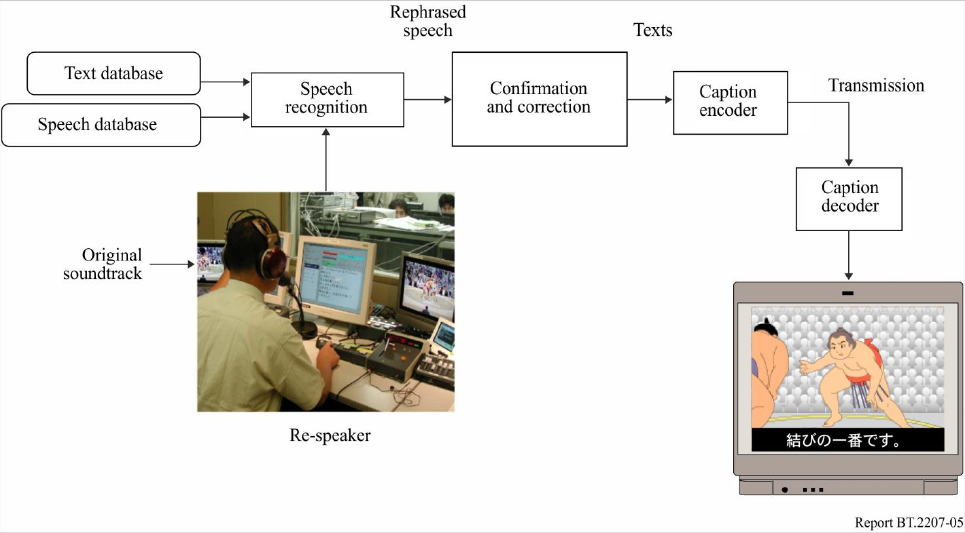
Rep. ITU-R BT.2207-6 9
The new speech recognizer runs on a PC. It automatically detects the gender of the speaker, which
allows the use of more accurate gender-dependent acoustic models [11]. As the switching of the
speech input is done manually with a small delay by the re-speaker, a speech buffer of about one
second is used to avoid losing the beginnings of utterances from the direct programme sound.
Moreover, the new system uses a manual correction method that requires only one or two flexible
correction operators depending on the difficulty of the speech recognition. Since four correction
operators (two pairs of an error pointer and an error corrector) were needed in the previous news
system, the new system is also superior in terms of operating costs. In an experiment on simple news
programmes with one anchor, the new system with two-correction operators achieved a caption
accuracy of 99.9% without any fatal errors. The new system was initially used to caption part of news
reporting on the disaster that occurred on 11 March 2011 and it has been employed to caption
nationwide regular short news since March 2012. The new system will help us to expand our closed-
captioned programme coverage, especially for such short news and local news programmes, since
their news styles are based on comparatively simple direction with only one anchor.
FIGURE 5
Closed-captioning system with a re-speak method
However, the system still is not good enough for large-scale news shows with more than one anchor
and spontaneous and conversational speaking styles. As a result, we are making efforts to improve
the speech recognition accuracy for such speaking styles.
Automatic closed captioning technology based on productions that have manuscripts available in
advance of transmission has been developed in the process of programme production for regional
broadcasting stations. This technology compares programme manuscripts with recognized speech and
instantly identifies the lines in the manuscripts corresponding to the speech. This makes it possible to
eliminate manual correction when producing closed captions for broadcasting [12].
A news programme may be prepared using multiple manuscripts and the presentation order is not
specified in advance. Often parts of the manuscripts may be skipped or rephrased. This makes it more
difficult to determine the target document based on the recognition results. The identification task
may also be complicated by speech recognition errors. To overcome these issues, a mechanism is

10 Rep. ITU-R BT.2207-6
incorporated a mechanism called a weighted finite-state transducer (WFST)
1
, which can accurately
estimate the manuscript segment that was read based on the recognized word sequence.
The system is also designed to prevent incorrect closed captions from being displayed by withholding
the closed-caption display on segments that do not have supporting manuscripts, such as interviews.
3 Multimedia browsing system for the visually impaired
Integrated information barrier-free environments that will enable people with visual impairments to
enjoy the wide variety of information services of digital broadcasting have been researched and
developed [13], [14].
Vast amounts of photographs, figures, tables and other visual content are delivered by digital
broadcasting and the Internet. Moreover, the graphical user interface (GUI) enabling users to visually
select news, weather, and other items of interest is by far the most pervasive way of choosing items
from a menu screen. While this is convenient for people without any disabilities, it is an enormous
barrier for people with visual impairments. Yet, everyone should be able to easily obtain information
from the television, since virtually everyone has one at home or has access to one.
Visual impairment covers a range of disabilities from poor eyesight to total blindness, and different
means of presenting information appropriate for all these degrees of disability are required. Audio
presentation of information is indispensable for people who are partially sighted or blind. People with
poor eyesight can comprehend information presented visually, but require an enlarged display of the
items for selection. People with restricted or “tunnel” vision require the displayed items to be shown
in a smaller area. In addition, people perceive brightness and colours differently, so the ability to
adjust the contrast between text and background or to adjust the colours of screen items and
background is also desirable. For people who are both deaf and blind, some method of tactile input
and output such as Braille or finger Braille is required.
The tactile-presentation of GUI is one method for visually disabled people to enjoy data broadcasting
and to interact with the Internet [15], [16]. This device forms figures and graphs on the tactile display
and has potential applicability as a general GUI for visually disabled people. With the tactile display
with optical touch panel, user can confirm details by audio or Braille, while navigating the GUI
interactively and touching the visual content. The tactile display has also algorithms to create real-
time Braille output of menu selection buttons for data broadcasting and text data in documents.
Figure 6 shows the barrier-free information reception/presentation system that can be tailored to the
type and degree of the viewer’s visual disability. It delivers data broadcasts, an Electronic Programme
Guide (EPG), and supports Braille-based closed-captioned data for the deaf blind. By connecting the
tactile display to a set-top-box (STB) type receiver (Visually Impaired Assist-TV: VIA-TV), it gives
visually impaired viewers the ability to interactively select menu items or figures/tables of data-
broadcast content [17].
1
WFST: technology for estimating words with the highest similarity. The technology is commonly used for
language processing and speech recognition.
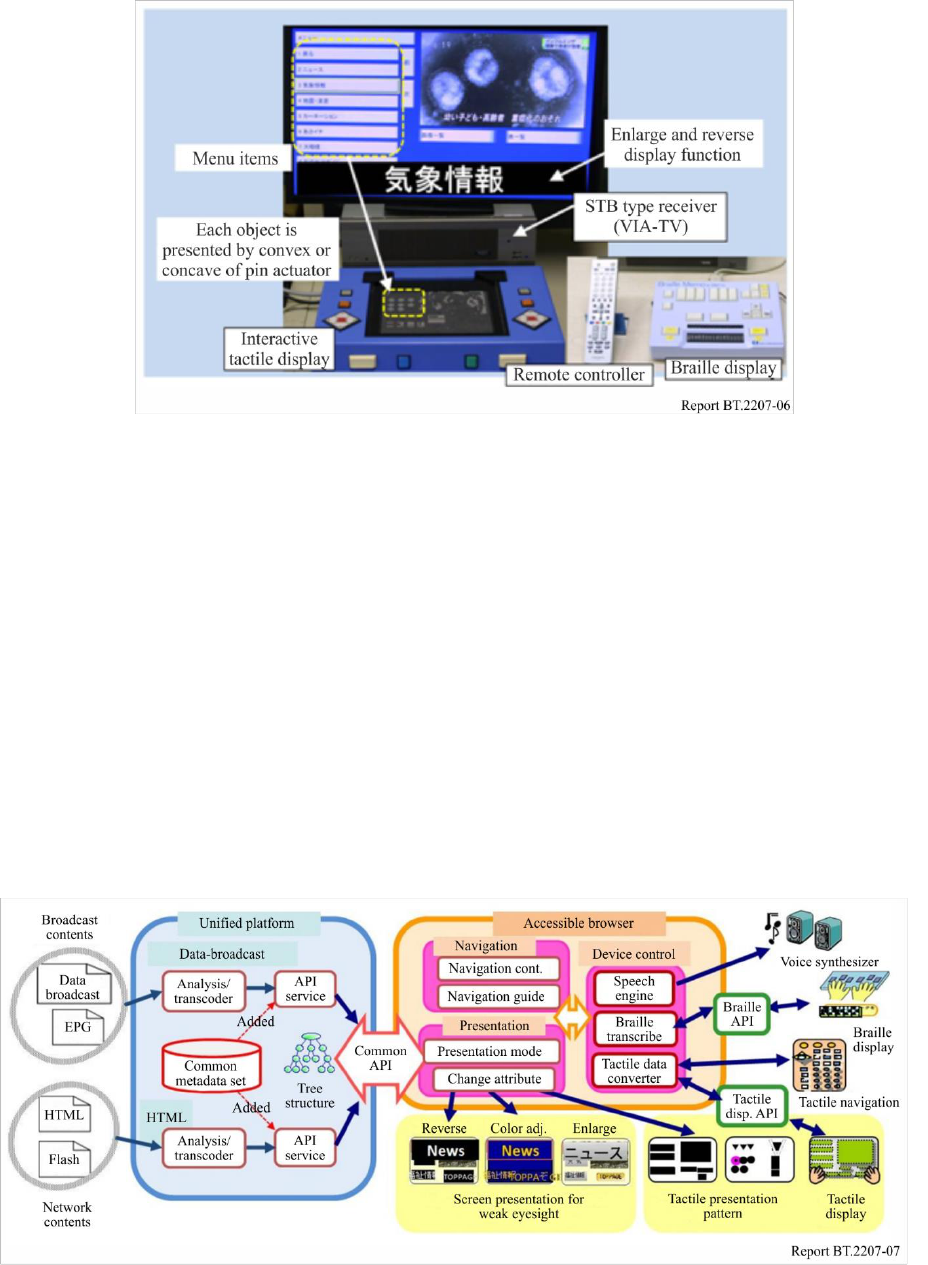
Rep. ITU-R BT.2207-6 11
FIGURE 6
Barrier-free Information reception/presentation system including VIA-TV
Figure 7 shows the configuration of the information barrier-free reception and presentation system.
The browser obtains content from the integration platform via the common API. The content received
is common representation data that is independent of presentation device and content format (tree
structure and table structure), and semantic information is added to it in the form of metadata. The
browser then converts the data to representation data for presentation by applying the various
presentation methods, and it restructures the content to make it easy for the visually impaired user to
understand. By modifying the attribute values of representations, the screen display can be enlarged
or the colour modified to accommodate a user with poor eyesight, a list presentation can be provided
for a tactile display, or other customized data can be output to devices.
In other words, the browser can present information that is tailored to the type and extent of the user’s
visual impairment or to the type of presentation device being used to improve access and
understanding of the multimedia content [13], [18].
FIGURE 7
Schematic diagram of information barrier-free reception and presentation system
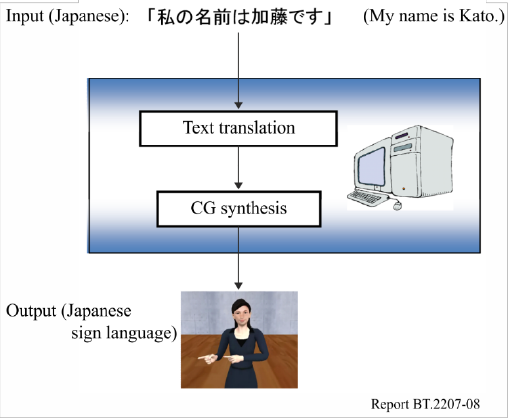
12 Rep. ITU-R BT.2207-6
4 Machine translation to sign language with CG-animation
In Japan, deaf people, especially those born deaf or who lost hearing in early childhood, use Japanese
Sign Language (JSL) to communicate with each other. JSL is a visual language in which words and
phrases are created using not only manual signals with hand and finger gestures, but also non-manual
ones with facial expressions, head movements and eye direction. These three-dimensional motions
make JSL grammar different from that in spoken Japanese, which has one dimension: sound. Due to
the different grammars, native signers understand JSL representations easier than spoken Japanese
ones.
In broadcasting, more TV services for deaf people are needed. Closed caption service using
transcription is one of such services and is widely used, partially helped with speech recognition
technology. Transcription is helpful for those who became hearing impaired later in life, while it is
difficult to understand for native signers, because it is based on spoken Japanese. Native signers truly
need more broadcasting services with JSL, which is their mother tongue. The simplest method to
increase JSL services is to increase the number of JSL translators engaging in translating TV
programmes from Japanese into JSL. However, this is difficult to do, because Japan has too few JSL
translators. Furthermore, JSL translators have to be taught to be able to translate TV programmes that
include a lot of jargon, and are difficult to find in the middle of the night to translate a breaking news
report about an earthquake, typhoon, or so on.
To overcome these problems, NHK has been studying machine translation (MT) from Japanese to
JSL with CG-animation. The MT system translates texts in Japanese into CG-animations in JSL.
Figure 8 shows an overview of our goal system for MT with CG-animation.
FIGURE 8
An overview of our goal system for MT with CG-animation
The MT system consists of two major processes: text translation and CG synthesis. Text translation
transfers words and phrases in Japanese into sequences of symbols that represent actions in JSL by
using a Japanese-to-JSL dictionary, and puts these sequences into a sentence by using a set of transfer
rules. CG synthesis generates seamless motion transitions between each symbol by using a motion
interpolation technique and adds non-manual signals to the animation.
As the first step to realize the MT system, a Japanese-to-JSL dictionary was recently developed.
Figure 9 shows an example of the online version of the bilingual dictionary.
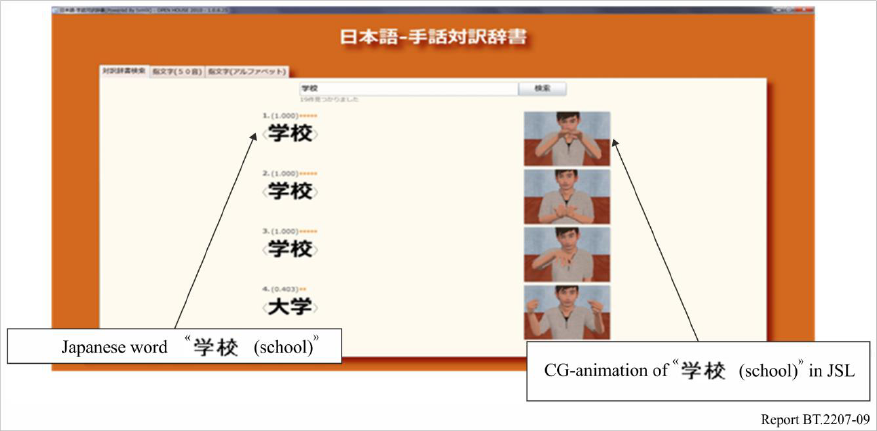
Rep. ITU-R BT.2207-6 13
FIGURE 9
A Japanese-to-JSL dictionary
The dictionary has 100 000 Japanese entries and 7 000 JSL entries with CG-animation. In the
dictionary, the number of Japanese entries automatically expands to 100 000 Japanese words from
7 000 Japanese basis words corresponding to the JSL entries due to our Natural Language Processing
(NLP) method, which exploits some synonyms in several lexicons to find the nearest ones in the
meaning and ranks the accuracy of the synonyms for a word by using a confidence measure defined
from their surface similarity and the number of the synonym lexicons in which they are registered
[19]. Meanwhile, the CG-animation defines a high-quality 3D human model of hands and fingers,
and controls the model using motion-capture data. The model has about 60 joints with three rotation
angles and can express most of manual signals in JSL [20]. CG-animation is rendered by scripts in
TVML (TV program Making Language), which is a scripting language developed by NHK to
describe full TV programmes [21].
A JSL corpus has also been constructed on daily NHK JSL News programs [22]. The corpus is utilized
for analysing JSL grammar and translation rules, and comparing CG-animated JSL gestures with
human ones. The corpus consists of Japanese sentences, their JSL translations and their JSL videos.
Figure 10 shows a browsing system for the corpus.
The Japanese sentences are transcribed by revising the speech recognition results of the news
programmes and their JSL translations are done by transferring the sign gestures of the newscasters
to JSL letters. The JSL videos are extracted along the time intervals of the transcribed JSL translations
by hand. The corpus is currently composed of about 130.000 sentences with these annotations.
A prototype system for MT from Japanese to JSL with CG-animation is under development,
integrating these basic technologies and improving each module of text translation and CG synthesis,
and will help deaf people to fully appreciate TV programmes.
An automatic CG sign language generation system has been developed, which converts weather
forecast data provided by the Japan Meteorological Agency in XML format into CG sign language
animations. The system can read coded weather forecasts and convey them through animated
characters using sign language. With the help of hearing impaired volunteers and sign language
interpreters, signing phrase templates and a signing motion database was created that correspond to
the weather forecast codes. The system receives and analyses the XML code, then inserts the relevant
information into the signing phrase templates, and then automatically generates the appropriate sign
language animations (see Fig. 11) [23], [24].
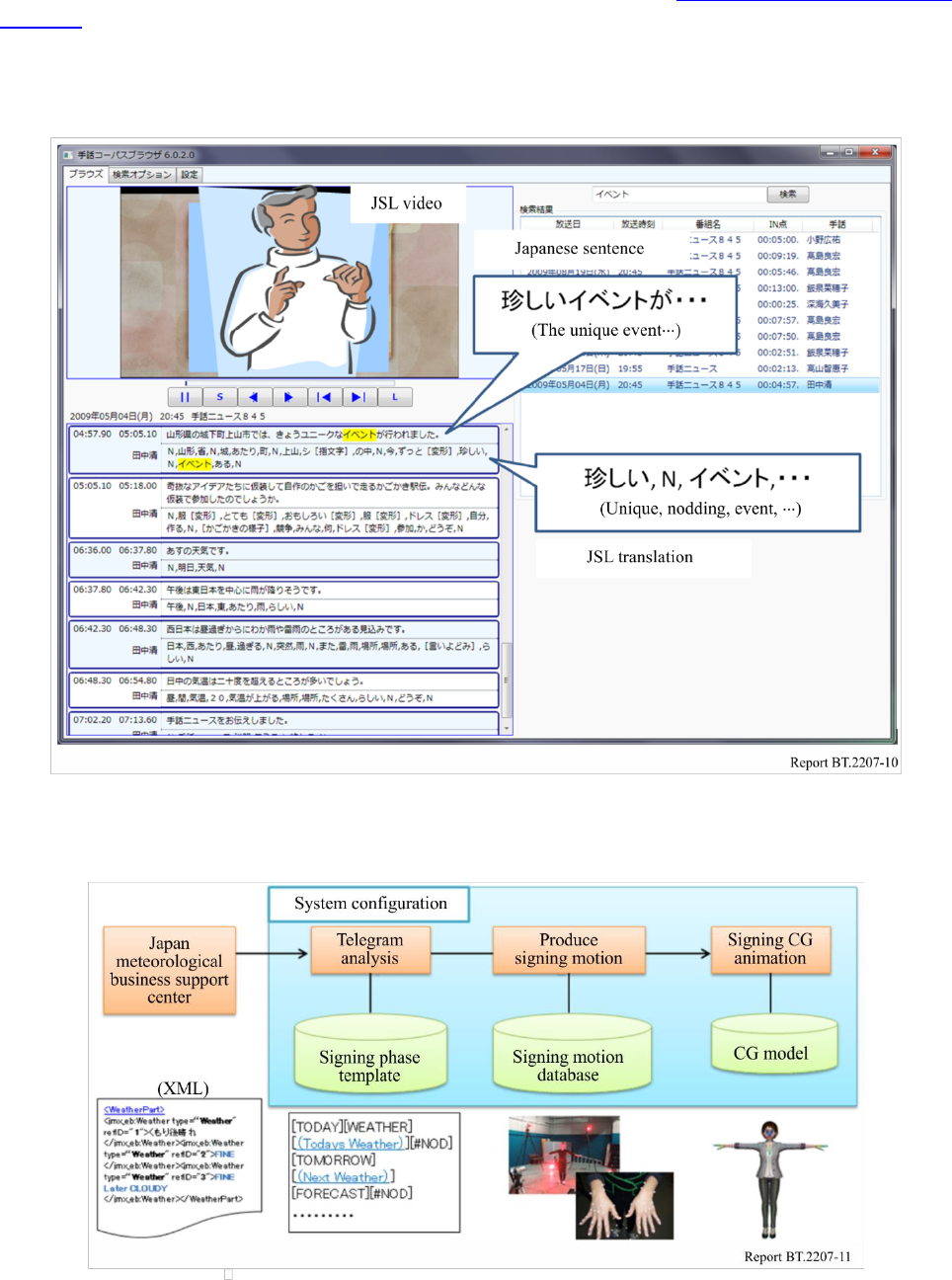
14 Rep. ITU-R BT.2207-6
The processing speed and stability of the system was improved by integrating processes from weather
data reception and CG sign language animation generation via data upload to a website. A website
for evaluating the CG sign language for weather report automatically generated by this system (see
Fig. 12) was released through NHK Online in February 2017. (See https://www.nhk.or.jp/strl/sl-
weather/)
FIGURE 10
A browsing system for the JSL corpus
FIGURE 11
Configuration of automatic CG sign language generation system for weather forecasts
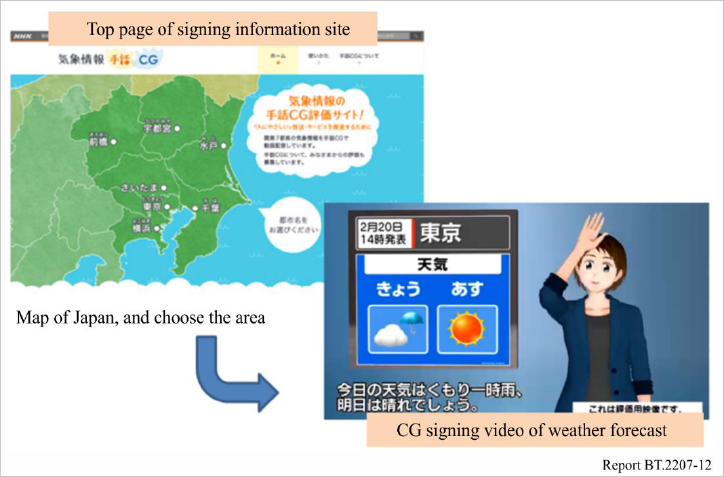
Rep. ITU-R BT.2207-6 15
FIGURE 12
Website for evaluating weather forecast sign language CG (on NHK online)
5 Device for evaluating broadcast background sound balance
Broadcast audio is produced with the aim of serving the public of all ages. However, it is known that
the minimum audible field (MAF) generally increases with age. It is also said that background sound
seems to become louder with age, causing difficulties in understanding spoken lines and narrations.
When producing broadcast programmes, the background sound balance is subjectively determined
by individual programme production mixers who have excellent hearing and do not adequately
appreciate the impact of age related hearing issues. To improve this situation, NHK has developed a
device that helps a mixer adjust the loudness of background sounds to an appropriate level. This
research focused on degradation of hearing acuity due to aging by taking the frequency bandwidth of
broadcast sound and composition of the sound source into account [25], [26].
Two factors were considered as the cause of perceiving background sound as loud or noisy. One is
the fact that with age it becomes more difficult to separate and understand the narration from
background sound. This may be caused by the degradation of inner ear function as well as the
deterioration of processing ability in the auditory centre. The other factor arises from a production
technique, often used in broadcast programmes, to enhance the mood by making background music
and sound effects louder when the sequence has no narration.
The recruitment phenomenon due to aging may cause over reaction to background sound and increase
the sensitivity to sound level changes. Perception of programme sound level by listeners in the age
range 60 to 72 was evaluated using loudness [27] as a parameter. In this experiment, it was found that
the listeners become annoyed if the loudness of the background sound is more than 2.5 phon louder
than the narration loudness level. It was also found that the listeners perceive background sounds as
louder when the difference in sound levels between the background sound and narration is less than
6 phon compared with when the difference is greater than 6 phon.
Based on these findings, a prototype system was developed for objectively evaluating the loudness
of broadcast TV programmes optimized for listeners in this age range [25], [28]. Figure 13 shows a
photograph and a block diagram of the system. The loudness levels of the narration and background
sounds are calculated from the audio signals. The background sound balance is represented as a series
of thresholds based on the loudness level, the difference in loudness level between the narration and
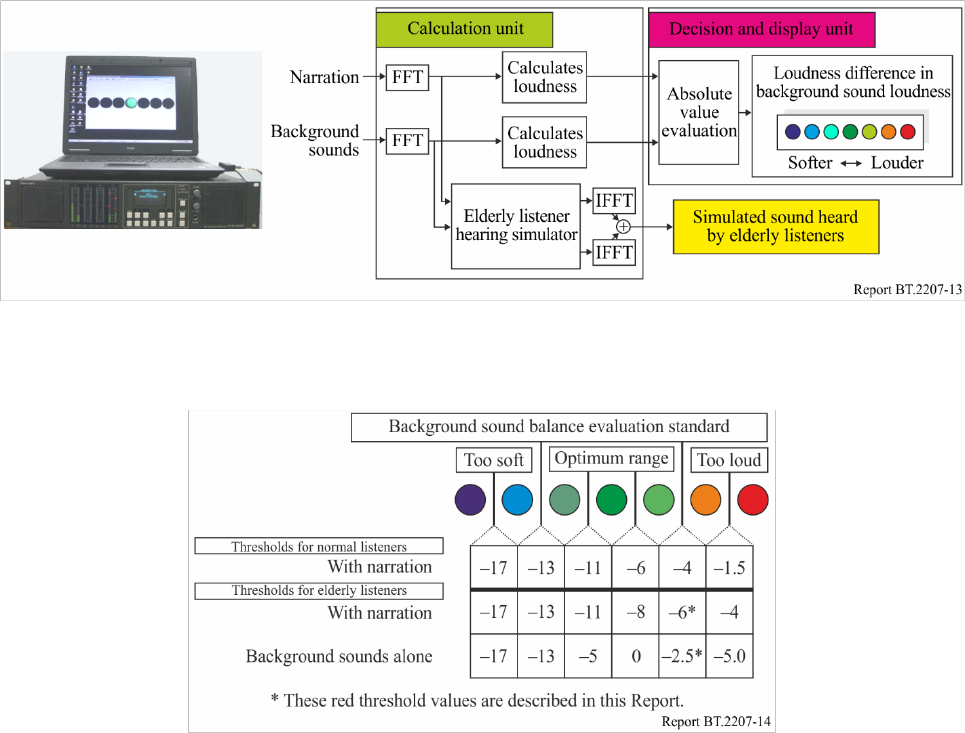
16 Rep. ITU-R BT.2207-6
background sound, and the listening level, and it is displayed as a seven colour-coded scale (blue,
aqua, blue-green, green, yellow-green, orange, red), with blue on the left signifying too soft, red on
the right signifying too loud, and green in the middle signifying the optimum sound level. Figure 14
shows the threshold values for a listening loudness level of 70 phon, which is equivalent to a listening
level of 75 dBA [28]. The Figure compares background sound balance thresholds for people with
normal hearing as determined by evaluating the programme production mixers [29] and thresholds
for an older age range. By the prototype system to enable programme production staff experience the
impact of age related hearing difficulty, a function to simulate deterioration of sound separation
ability as well as the recruitment phenomenon is also introduced.
The prototype system was tested at a broadcasting station and found to be an extremely useful tool
for aiding in the production of TV programmes with the optimal sound volume balance for a wider
age range of listeners. Refinements and improvements are currently being incorporated into the
prototype system.
FIGURE 13
Externals and block diagram of prototype evaluation system
FIGURE 14
Loudness level thresholds when listening loudness level is 70 phon
6 Easy-to-read language broadcasting service and language conversion support
technology
The difficulty level of language used in broadcasts in general is based on the assumption that the
audience consists of native speakers who are able-bodied listeners of a certain age. This means that
many are likely to find this level of language rather difficult to understand – including non-native
Rep. ITU-R BT.2207-6 17
speakers, children, people with developmental impairments, and people with cognitive losses due to
aging – which raises the prospect of a broadcast language barrier.
One way to solve this problem would be to provide broadcasting services tailored to the language
comprehension level of these different groups. NHK has begun researching an easy Japanese
broadcasting service tailored to the language proficiency level of foreign residents who are capable
of speaking everyday conversational Japanese [30].
Japan currently has approximately 2.38 million non-native Japanese speakers, 1.9% of Japan’s
population – this population is so diverse that it is virtually impossible to provide broadcasts in all of
the native languages of residents in Japan. At the same time, surveys have shown there is demand for
broadcasts in easy Japanese [31], so there is certainly a need for such services.
The first objective was to come up with a service for converting the regular news content that is
posted on the Web into easy Japanese content.
This involves three basic tasks: (1) figuring out the proper level of language difficulty that is tailored
to the comprehension level of foreign residents who speak Japanese as a second language, (2)
providing Web functions that further aid understanding of easy Japanese, and (3) developing a support
system that translates ordinary Japanese into easy Japanese. Although these issues are still being
worked out, a public trial service called NEWS WEB EASY was launched in April 2012 based on
machine-aided human translations of daily news articles into easy Japanese. This report will propose
solutions to the issues outlined above and go into a bit more detail about the trial NEWS WEB EASY
service. At the end of the report, a brief summary and a number of future challenges will be presented.
6.1 What does easy Japanese mean?
The audience for these services is foreign residents learning Japanese as a second language who are
already fairly fluent in conversational Japanese, but now want to learn how to read news articles and
the newspaper. In other words, the focus is on foreign residents who have achieved pre-intermediate
level Japanese. One way to define Japanese that matches this level of comprehension is to examine
the standard process of Japanese language learning as a second language, and this suggests the
following guidelines.
Vocabulary
Rewrite news articles by sticking as closely as possible to the elementary vocabulary that foreign
residents learn at the initial stage of their study. For this purpose, the basic words listed in the test
guidelines of the “Japanese language proficiency test” are currently being used [32]. Note that a
number of terms not from this list are also used, including technical terms, proper names, and terms
that frequently appear in news articles yet are difficult to reword in easy words.
Grammar
In terms of grammar, guidelines determine which functional expressions (such as passive, causative,
hearsay, and intent expressions) are considered acceptable and define the degree of syntactic
complexity of target phrases. Again, as with the vocabulary items, the policy was to use functional
expressions that foreign residents are likely to learn at the beginning of their study. For example, the
passive form was avoided as much as possible, since this is hard for people at a beginning level of
Japanese to understand. However, there are a few exceptions. For example, considering the way news
is quite often reported as hearsay, a few advanced level hearsay type expressions such as “to-shite-
imasu (it has been reported that)” and “to-iukoto-desu (it is explained that)” were included. While
these are generally not used in everyday conversation and are somewhat difficult, they are essential
if one is to read and understand the news. Regarding syntactic complexity, the following guideline
was adopted. Longer sentences typically tend to be more syntactically complex and harder to
understand. To reduce syntactic complexity and facilitate clear understanding, long wordy sentences
18 Rep. ITU-R BT.2207-6
were broken into smaller sentences. Sentences in news copy that exceed 100 characters in length are
extremely difficult to understand, so sentences are shortened to 60 characters or less.
Curtail information
There tends to be a lot of redundancy in Web news content. This is because news copy is often written
based on a script prepared to be broadcast by voice over the radio. To streamline and simplify the
Japanese, this duplication was eliminated. Supplemental information was also reduced as much as
possible, which makes the easy Japanese version significantly shorter than the original news story.
6.2 Web service functions
Besides measures for simplifying Japanese itself as outlined above, a number of Web functions that
aid the user in understanding the news were also provided. The following functions have been
implemented in the public trial version of NEWS WEB EASY that is now available.
Furigana (ruby) characters
Japanese is written using a combination of Chinese characters (kanji), two types of Japanese phonetic
symbols (hiragana and katakana), as well as alphabetical characters (romaji) and numbers. Kanji are
notoriously difficult for foreigners to master because there are so many of them and because the same
characters can be read in different ways depending on the context. Foreign residents thus often find
themselves unable to understand the meaning of words written in kanji. To assist them in reading
kanji, very small kana characters called furigana are printed above all kanji, indicating how they are
correctly pronounced. This increases the chances of foreign readers being able to understand the
meaning of kanji terms even if they are unable to read the kanji.
Glossaries
The basic approach is to write easy Japanese using elementary vocabulary, but it is generally not
possible to convert all of the difficult terms to simple vocabulary. One solution might be to add a
phrase explaining such terms in a sentence, but this would only lengthen the sentence and make it
harder to understand. For this situation, glossaries are employed to explain difficult terminology.
A glossary entry is accessed by merely positioning the cursor over the word on the NEWS WEB
EASY trial screen. A popup is then displayed which explains the term. For the purposes of this trial,
a dictionary for Japanese elementary school students was used to provide the glossary entries.
Proper nouns
Proper nouns – names of people, places, organizations, and so on – are unavoidable in news articles,
and of course proper nouns are not included in any pre-existing glossary. Different classes of proper
nouns are highlighted in different colours to draw the readers’ attention. The reader may not know
exactly what the terms mean, but at least he or she is able to differentiate the names of people, places,
and organizations.
Text-to-speech
Some foreign residents have difficulty reading Japanese, yet are perfectly capable of understanding
the text if it is read to them. NEWS WEB EASY features a text-to-synthesized voice function for
people who fall into this category.
Figure 15 shows a screen shot of the NEWS WEB EASY trial, highlighting the features described.
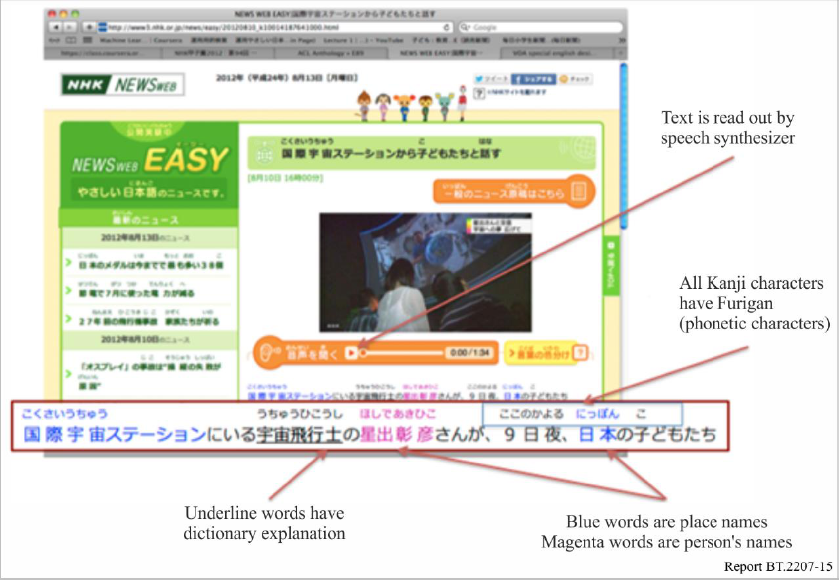
Rep. ITU-R BT.2207-6 19
FIGURE 15
Screen shot of the NEWS WEB EASY application
6.3 Rewrite support system
Translating articles into Easy Japanese is done in pairs by a news editor (a reporter) and a rewriter (a
Japanese instructor trained in easy Japanese guidelines). The rewriter rewords the news stories
without deleting any information, while the news editor deletes redundant and supplemental
information and checks the accuracy of the rewritten content. The editors and rewriters are experts in
their respective fields, but they do not have any experience in translating ordinary Japanese into easy
Japanese. Rewriting work is far harder than one might imagine. To assist with the rewrite work, a
special editor [33] and a model phrase search system have been developed.
Rewrite support editor
One of the challenges facing the rewriter and the editor is figuring out which parts of the text should
be rewritten. It was noted earlier that difficult words (words that go beyond the elementary vocabulary
level) and overly long phrases and sentences should be rewritten, but it is difficult to manually identify
all of the places that should be reworded. To simplify this task, a function that automatically highlights
these places and assigns a numerical index of difficulty was developed. Editors and rewriters are less
likely to overlook spots marked for rewriting because they can see them at a glance. Another
challenge is assessing the actual effects of rewriting. For example, it is sometimes difficult to
determine whether rewriting actually simplifies the text or note specially if the editor is not well
versed in the rules of easy Japanese. Here again, assistance is offered in the form of a function that
assesses the overall difficulty of an article and then assigns a numerical value to the difficulty. The
value factors in several criteria: the number of difficult words included in the article, the average
length of sentences in the article, and the overall length of the article. The smaller the value, the
simpler the article. By simply checking whether the value has gone up or down after rewriting, the
editor and the rewriter know whether their efforts have improved the article or made it worse.
20 Rep. ITU-R BT.2207-6
Model phrase search system
The rewrite support editor quickly identifies wordy or difficult passages, but does not offer alternative
suggestions that might improve the article. For this, a database system was developed that continually
stores articles before and after rewriting. The system automatically searches for and proposes simpler
phrases to substitute for difficult phrases input by the rewriter. Using the system, for example, one
can easily search for an alternative phrase to substitute for the common yet difficult hearsay
expression “to-shite-imasu (it has been reported that)”. This system makes it easy for rewriters to
share experience and knowledge in the course of their work.
6.4 Future challenges
The NEWS WEB EASY trial has gone very smoothly since it was rolled out in April 2012, with two
or three new articles released every day. Right now, news in easy Japanese is being assessed by
polling users and by testing the comprehension of foreign residents using this service. Preliminary
results suggest that the service has great promise and should be highly effective for conveying news
to people at a pre-intermediate level of Japanese. Building on the promising results achieved so far,
the easy Japanese guidelines will be fine-tuned to produce news articles that are even more
transparent. An automatic translation function is also being developed that will significantly enhance
the rewrite efficiency of the system.
7 Sound level adjustment system with a speech rate conversion (SRC) for channel-based
stereo signals
As the average age of the television audience increases, broadcasters receive more comments from
viewers that the narration in broadcast programmes is difficult to hear. There are two main reasons
for that: (1) the background sound (music and sound effects) in broadcast programmes disturbs the
viewers’ recognition of narration, speech, comments, or dialogue; (2) the narration or speech is too
rapid for an aging population. Concerning the issue of background sound in broadcast programmes,
Nakamura et al. [34] reported reducing the background levels by only 3-6 dB lower than usual would
make the narration easier to understand by a wider age range. Imai et al. [35] have shown that
decreasing the speech rate when there is no background sound (as in a newscast) makes it easier to
hear (see § 1). This section describes a prototype of a sound level adjustment system with a speech
rate conversion for channel-based stereo signals.
7.1 Prototype speech rate conversion system
A block diagram of the prototype system is shown in Fig. 16. The stereo sound correlation (SSC)
block divides the input stereo signals into an estimated speech signal and two estimated background
sound signals. The spectral contrast enhancement (SCE) block enhances only the estimated speech.
The speech rate conversion (SRC) block converts the speech rates of all the sound signals (estimated
speech, estimated background sound, enhanced speech, and original sound). Using the
speech/nonspeech segment information estimated by the voice activity detector, the system controls
the speech rate and the gain of each signal.
The sound level adjustment system can adjust a mixing balance of the speech and background sound
by varying the multipliers α, β, γ and η. The multipliers α and β adjust the reproduction level of the
enhanced speech and the estimated speech, respectively. The multiplier γ adjusts the estimated
background sound signal. The multiplier η adjusts the level of the original sound signal in the
nonspeech segments. The background sound signal can be suppressed by decreasing γ and η. The
gain control is performed depending on the speech/nonspeech segment information.
The SSC block employs an adaptive filter for background sound separation [36]. Using a time-varying
filter, the SSC block can extract the correlated signal from the original stereo signal as the estimated
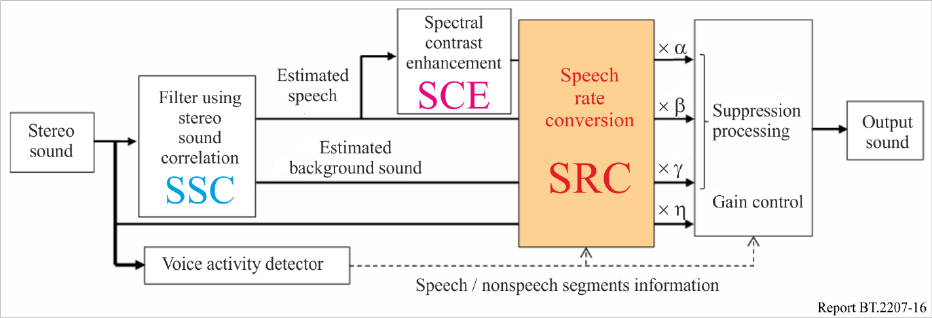
Rep. ITU-R BT.2207-6 21
speech signal. The uncorrelated signals, which are the estimated background sound signals, are
obtained by subtracting the estimated speech signal from the original signals of the left and right
channels.
The SCE block performs three procedures. In the first step, the estimated speech signal is divided into
about 80 signals with different bandwidths. In the second step, the band signal levels with a peak in
the spectral envelope are increased by filtering with steep characteristics, and in the third step, the
band signal levels with a dip in the spectral envelope are suppressed by the filter of gentle curve
characteristics. These combined filters enhance the contrast of the spectral envelope [37].
The SRC block adjusts the speech rate (see § 1).
The voice activity detector estimates the segmentations of the speech and nonspeech periods using
amplitude information and the likelihood of phoneme recognition.
The prototype system (see Fig. 17) can replay video in synchronisation with the speech-rate-
converted audio signal. This is realised by converting the frame rate of the video signal according to
the SRC.
FIGURE 16
Block diagram of a sound level adjustment system with a speech rate conversion for stereo signals
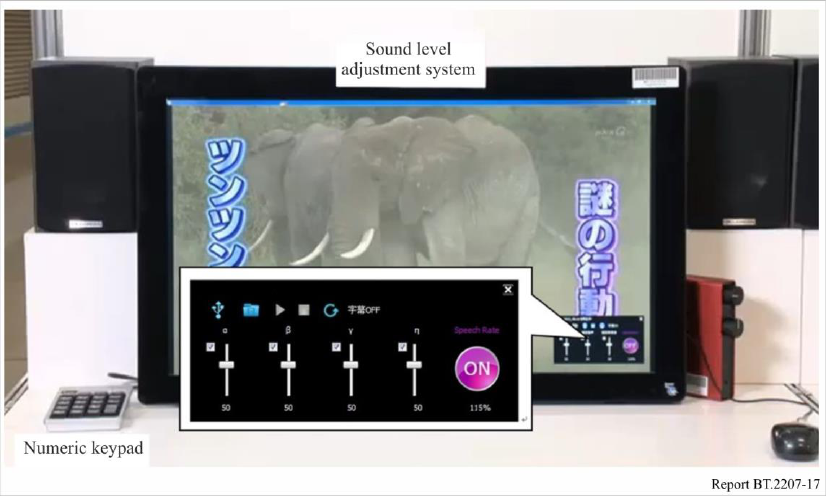
22 Rep. ITU-R BT.2207-6
FIGURE 17
Prototype of the sound level adjustment system with a speech rate conversion for stereo signals
In cases without the SRC, an evaluation experiment showed that a 15 dB suppression (γ = 0.178) of
the estimated background sound had the same effect of a 4.5 dB suppression of the actual background
sound, whereas a 3-6 dB suppression is the target in accordance with [34]. The SCE with optimal
parameters additionally improved the suppression effect of 1 or 2 dB [38], [39]. Therefore, the sound
level adjustment system using both SSC and SCE achieved the target suppression of 6 dB on average
through a 15 dB suppression of the estimated background sound.
7.2 Subjective evaluation
Subjective evaluation experiments were conducted to confirm how the prototype system could
improve the audibility of stereo sound for an aging audience.
The effect of mixing balance adjustment was evaluated using selected test materials ‒ each about 20
to 30 s long and including TV dramas ‒ that had been reported to be difficult to hear. Using the
prototype system, the mixing balance of the enhanced speech, the estimated speech, the estimated
background sound was adjusted in the speech segment and the speech rate was changed 15% slower,
i.e. a speech rate of about 6-7 mora/s, for older viewers prefer according to the results of a previous
research [35]. Four sets of mixing balance were evaluated.
Sixteen subjects representative of an older audience (twelve subjects were normal hearing (NH) group
and four subjects were lower hearing ability (LH) group) participated in the test conducted in a
soundproof room. The LH group’s hearing in 2-8 kHz frequency bands is particularly poor, indicating
that high-frequency sounds are difficult to comprehend. The subjects were asked to judge the easiness
of hearing using the seven-grade criteria to any pairs of four sets of mixing balance.
The result showed that when the mixing balance was adjusted to reduce the background sound, the
average scores were higher than that for the original sound, demonstrating significant effects of
background sound level adjustment [40].
Additionally, the effect of adding SRC to the sound level adjustment was also evaluated [40]. This
result indicated that the sound level adjustment with SRC was more effective than the sound level
adjustment without SRC for those with age related hearing loss.
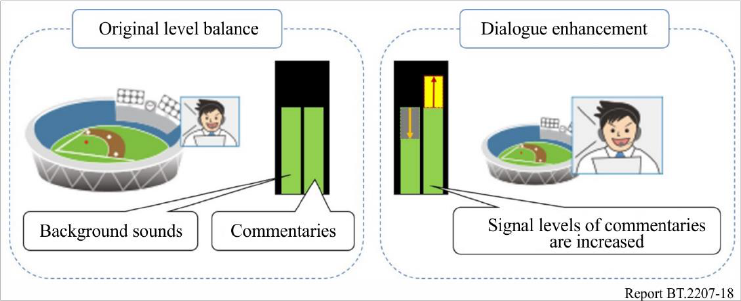
Rep. ITU-R BT.2207-6 23
8 Personalization that improves accessibility using object-based sound technology
Object-based sound systems enable listeners to adjust the balance of the signal levels of audio objects,
to change the positions of individual audio objects and to switch different dialogue objects and audio
descriptions. These features can effectively improve accessibility to broadcasting services.
8.1 Dialogue enhancement
Dialogue enhancement helps the audience to better hear and understand commentary by controlling
the signal levels of individual audio objects (see Fig. 18). Different user interfaces can be considered.
– Listeners adjust the balance of the sound levels of the audio objects (e.g. the balance between
the signal levels of the dialogue/commentary and background sounds/music). Broadcasters
can limit the range that signal levels can be adjusted within.
– Listeners select a programme of different signal level balances provided by broadcasters. The
signal level of the dialogue object can be set 3 to 6 dB louder than that in the original mix.
While this user interface may not provide the balance preferred by individual listeners, it is
easier to adjust.
FIGURE 18
Example of dialogue enhancement
8.2 Audio description and multilingual dialogues
Object-based sound systems can provide supplementary audio content. One example is audio
description objects that describe the audio-visual content for visually impaired persons. Audio
description objects are delivered simultaneously to the original audio-visual content. Another
example is multilingual dialogues for the non-native audience in which dialogues in different
languages are delivered as different audio objects. Listeners can choose their preferred language.
9 Haptic information presentation technology
Broadcasting is a medium for conveying mainly visual and audio information, but adding haptic
information to video and audio content would enable even visually or hearing impaired persons to
understand the content of broadcasts. In sporting events, for example, the status of a match could be
intuitively understood by vibrating a haptic device during the rally of a ball or at the moment of its
bounce. In addition, the sense of presence at a match could be enhanced through haptic stimuli
enabling broadcast services to provide fascinating experiences to everyone.
Figure 19 shows the flow of haptic information presentation linked with broadcast content. Providing
haptic information during a live broadcast such as a sporting event requires that information related
to haptic stimuli can be obtained automatically in real time. First, video analysis, shown on the left in
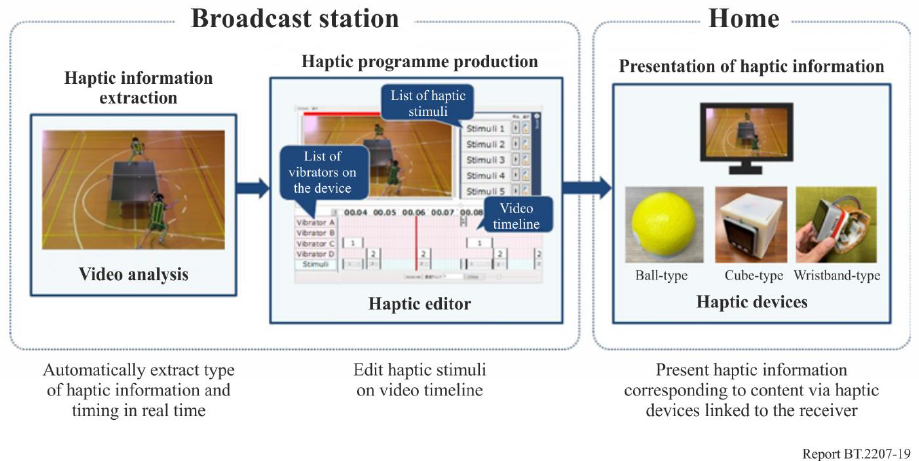
24 Rep. ITU-R BT.2207-6
the Figure, measures the movement of the athletes and of the ball and obtains the types of haptic
stimuli and their timing from the video programme. Next, the haptic information obtained in this way
is edited on the video timeline using the haptic editor, shown in the center of the Figure, so that the
timing of the haptic stimuli is right with the programme. Finally, the haptic stimuli associated with
the TV programme are delivered to the audience via broadcasting or IBB and presented to the user
via the haptic device linked to the receiver.
Haptic devices include a ball-type device that can express ball-impact timing and direction of
movement [41], a cube-type device that can express the three-dimensional relationship among
athletes, ball, etc., and a wristband-type device that can stimulate the wrist of a user with four vibrators
[42]. Using such a haptic device according to the type of sporting event or programme genre makes
it possible to provide optimal haptic information to the user. The presentation of information using
haptic stimuli in the above way should serve as “universal media” that can be used by any type of
audience including visually or hearing-impaired persons.
FIGURE 19
Flow of haptic information presentation linked with broadcast content
10 Audio descriptions
Audio descriptions enable the visually impaired audience to enjoy broadcast programmes through
communicating the status of a drama’s story and the progress of a sports game by providing
supplementary information such as a person’s actions and facial expressions that are difficult for the
visually impaired to understand from the main audio content. Real-time audio descriptions will help
the visually impaired enjoy live sports broadcast programmes.
10.1 Audio Descriptions, example for Live Broadcasts
When adding audio descriptions to a live broadcast programme within an existing broadcast
framework, appropriate expression of supplementary information should be provided instantaneously
and timely. According to a study, in the case of a sports programme, the names of players, actions
and timings of plays, and scores make up about 80% of the information needed for the visually
impaired audience to better understand the state of the game. [43, 44]

Rep. ITU-R BT.2207-6 25
A system for the creation and delivery of audio descriptions was prototyped by NHK (Fig. 20). At
the production side, while watching the video, an operator selects and pushes a button corresponding
to the event or state of the game from a list on an event input tool dedicated to sports programmes,
such as tennis, table tennis, badminton, basketball, and baseball. Information that can be determined
in accordance with the progress of the game, such as the name of the next player, is automatically
generated, which can reduce the number of button operations. The descriptive text is then uploaded
to the cloud server.
The descriptive text is automatically transformed to the audio descriptions by speech synthesis. Two
different types of audio descriptions, spoken by a male and female speaker, are created. Audio
descriptions upon users’ preference settings are then instantly delivered to the users’ smartphones
from the delivery server.
Users can listen to the audio descriptions via the application installed on their smartphones. The
application has easy-listening functions that enable the user to choose the gender of the speaker and
the speaking speed and can also enhance the high frequency component of the audio descriptions.
FIGURE 20
Audio descriptions creation and delivery system
References
[1] NAKAMURA, A., SEIYAMA, N., IMAI, A., TAKAGI, T. and MIYASAKA, E. [1996] A New
Approach to Compensate Degeneration of Speech Intelligibility for Elderly Listeners. IEEE Trans.
Broadcast., Vol. 42, 3.
[2] IMAI, A., SEIYAMA, N., TAKAGI, T. and MIYASAKA, E. [2001] Evaluation of Speech Rate
Conversion for elderly people. Proc. of the International Workshop on Gerontechnology.
[3] IMAI, A., SEIYAMA, N., MISHIMA, T., TAKAGI, T., and MIYASAKA, E. [2001] Application of
speech rate conversion technology to video editing – Allows up to 5 times normal speed playback
while maintaining speech intelligibility. Proc. AES 20th International Conference, 3-5, p. 96-101.
26 Rep. ITU-R BT.2207-6
[4] IMAI, A., TAKAGI, T., and TAKEISHI, H. [2005] Development of radio and television receiver
with functions to assist hearing of elderly people. IEEE Trans. Consumer Electronics, Vol. 51, No. 1,
p. 268-272.
[5] IMAI, T., HOMMA, S., KOBAYASHI, A., SATO, S., TAKAGI, T., SAITOU, K. and HARA, S.
[2007] Real-Time Closed-Captioning Using Speech Recognition. ABU Technical Committee 2007
Annual Meeting, Doc. T-7/42-3.
[6] ANDO, A., IMAI, T., KOBAYASHI, A., ISONO, H., and NAKABAYASHI, K. [2000] Real-Time
Transcription System for Simultaneous Subtitling of Japanese Broadcast News Programs. IEEE
Transactions on Broadcasting, 46(3): 189-196.
[7] IMAI, T., MATSUI, A., HOMMA, S., KOBAYAKAWA, T., ONOE, K., SATO, S. and ANDO, A.
[2002] Speech Recognition with a Re-Speak Method for Subtitling Live Broadcasts. Proc. of
International Conference on Spoken Language Processing, p. 1757-1760.
[8] MARKS, M. [2003] A distributed live subtitling system. BBC R&D White Paper, WHP070.
[9] IMAI, T., KOBAYASHI, A., SATO, S., TANAKA, H. and ANDO, A. [2000] Progressive 2-Pass
Decoder for Real-Time Broadcast News Captioning. IEEE International Conference on Acoustics,
Speech, and Signal Processing (ICASSP), p. 1559-1562, Vol. 3.
[10] HOMMA, S., KOBAYASHI, A., OKU, T., SATO, S., IMAI, T. and TAKAGI, T. [2008] New Real-
Time Closed-Captioning System for Japanese Broadcast News Programs. 11th International
Conference on Computers Helping People with Special Needs (ICCPH).
[11] IMAI, T., SATO, S., KOBAYASHI, A., ONOE, K. and HOMMA, S. [2006] Online Speech Detection
and Dual-Gender Speech Recognition for Captioning Broadcast News. Proc. of the 9th International
Conference on Spoken Language Processing (Interspeech 2006-ICSLP), Wed1CaP-1.
[12] SATO, S., ONOE, K., KOBAYASHI, A., OKU, T., ICHIKI, M. and ARAI, T.: “Recent
Developments in Automatic Captioning System for Regional Broadcasting Station,” The Special
Interest Group Technical Reports of IPSJ, Vol. SLP-103, No. 1 (2014) (in Japanese).
[13] SAKAI, T., HANDA, T., MATSUMURA, K., KANATSUGU, Y., HIRUMA, N. and ITO, T. [2007]
Information Barrier-free Presentation System for Visually Impaired Users. CSUN Technology
& Persons with Disabilities Conference 2007.
[14] HANDA, T., SAKAI, T., MATSUMURA, K., KANATSUGU, Y., HIRUMA, N. and ITO, T. [2007]
Accessible EPG and Closed Caption for Visually Impaired Persons. CSUN Technology & Persons
with Disabilities Conference 2007.
[15] SAKAI, T., KONDOH, S., MATSUMURA, K. and ITO, T. [2005] “Improving Access to Digital
Broadcasting for Visually Impaired Users”, International Conference on Human-Computer
Interaction 2005.
[16] HANDA, T., SAKAI, T., MATSUMURA, K., KANATSUGU, Y., HIRUMA, N. and ITO, T. [2007]
An Evaluation of Accessibility of Hierarchical Data Structures in Data Broadcasting Using Tactile
Interface for Visually-Impaired People. 12th International Conference on Human-Computer
Interaction (HCI2007), Universal Access in HCI, Part III, HCI2007, LNCS4556, p. 45-54.
[17] SAKAI, T., HANDA, T., OKOCHI, N., and IFUKUBE, T.: “A Development Evaluation of Digital
Broadcast Receiver and UI for Visually Impaired People,” IEICE HCG Symposium, HCG2011-B3-4,
pp. 154-159 (2011) (in Japanese).
[18] MATSUMURA, K., SAKAI, T. and HANDA, T. [2007] Restoring Semantics to BML Content for
Data Broadcasting Accessibility, 12
th
International Conference on Human-Computer Interaction
(HCI2007), Universal Access in HCI, Part III, HCI2007, LNCS4556, p. 88-97.
[19] KATO, N., KANEKO, H., INOUE, S., SHIMIZU, T. and NAGASHIMA, Y. [2009] Construction of
Japanese sign language lexicon – Automatic Expansion of Japanese vocabulary. Proc. of IEICE HCG
Symposium 2009, I-3 (In Japanese).
Rep. ITU-R BT.2207-6 27
[20] KANEKO, H., HAMAGUCHI, N., DOKE, M., INOUE, S. and SHIMIZU, T. [2009] A Study of Sign
Language Animation using TVML. Proc. of IEICE WIT2008-82, p. 79-83 (In Japanese).
[21] HAYASHI, M. [1998] TVML (TV program Making Language) – Automatic TV Program Generation
from Text-based Script. Proc. of Siggraph 98.
[22] KATO, N. [2010] Construction of JSL News corpus. Proc. of 16
th
Annual Meeting of The Association
for Natural Language Processing, p. 494-497 (In Japanese).
[23] HIRUMA, N., AZUMA, M., UCHIDA, T., UMEDA, S., MIYAZAKI, T., KATO, N., INOUE, S.
[2015] Automatic Generation System of Japanese Sign Language (JSL) with CG Animation of Fixed
Pattern Weather Information. ABU Technical Review, no.264, 2015, p. 2-5.
[24] AZUMA, M., HIRUMA, N., UCHIDA, T., MIYAZAKI, T., INOUE, S., UMEDA, S., KATO, N.,
[2016] Development of Automatic Sign Language Animation System to Express Weather Warnings.
Proc of IEICE Technical Report, Vol.116, No.248, WIT2016-35, pp.11-15 (2016) (in Japanese).
[25] KOMORI, T., TAKAGI, T., KUROZUMI, K. and MURAKAWA, K. [2008] An Investigation of
Audio Balance for Elderly Listeners using Loudness as the Main Parameter, AES 125
th
Convention
Paper 7629.
[26] KOMORI, T. and TAKAGI, T. [2009] A study of elderly people’s hearing loss and the subjective
evaluation result from varying background sound level of TV program, ITE Winter Annual
Convention, 4-9, (in Japanese).
[27] ZWICKER, E., FASTL, H., WIDMANN, U., KURAKATA, K., KUWANO, S. and NAMBA, S.
[1991] Program for calculating loudness according to DIN 45631 (ISO 532B), J. Acoust. Soc. Ja.
(E)., Vol. 12, pp. 39-42.
[28] KOMORI T., TAKAGI, T., KUROZUMI, K., SHODA, K. and MURAKAWA, K. [2010] A Device
to Evaluate Broadcast Background Sound Balance Using Loudness for Elderly Listeners, ICCHP
2010, Part II, LNCS6180, pp. 560-567.
[29] KOMORI, T., KOMIYAMA, S., DAN, H., TAKAGI, T., SHODA, K., KUROZUMI, K., HOSHI, H.
and MURAKAWA. K. [2009] A Investigation of the Audio Balance Control based on the Loudness
Level, IEICE Transactions, Vol. J92-A, No. 5, pp. 344-352, (in Japanese).
[30] TANAKA, H. and MINO, H. [2010], Manual Translation Experiment of Broadcast News in Simple
Japanese, Information Processing Society of Japan, IPSJ SIG Notes 2010-NL-199 (11), pp. 1-8,
11 Nov. 2010, (in Japanese).
[31] YONEKURA, R. [2012], Media Use and Information Behaviour of Foreign Residents in Japan When
Disasters Occur, The NHK Monthly Report on Broadcast Research, Aug. 2012, (in Japanese).
[32] JAPAN FOUNDATION [2002], Association of International Education: Japanese Language
Proficiency Test Content Specification, (in Japanese).
[33] MINO, H. and TANAKA, H. [To appear 2012], Rewrite Support Tool for Converting New Stories
into Easy Japanese News: Targeting Foreigners Residing in Japan, Annual Conference of the Institute
of Image Information and Television Engineers, (in Japanese).
[34] NAKAMURA, H., SAWAGUCHI, M., MASAOKA, K., WATANABE, K., YAMASAKI, Y.,
MIYASAKA, E., YASUOKA, M., SEKI, H. [2003] Better Audio Balance Broadcasting Service for
Elderly People: Background Sound Levels of Television Programs for Easy Listening. Proc. Spring
Meet. Acoust. Soc. Jpn., 1-5-5, pp. 455–456 (in Japanese).
[35] IMAI, A., SEIYAMA, N., TAKAGI, T., MIYASAKA, E. [2001] Evaluation of Speech Rate
Conversion for Elderly People. Proc. of the International Workshop on Gerontechnology.
[36] MURAYAMA, Y., HAMADA, H., KOMIYAMA, S., KAWABATA, Y. [2007] Adaptive Control
for Advanced Reproduction of Narration Voice. 13
th
AES Regional Convention, Tokyo.
[37] TAKOU, R., SEIYAMA, N., IMAI, A., KOMORI, T., TAKAGI, T. [2012] A Study on Spectrum
Contrast Enhancement for Sentence Speech Intelligibility in Noise for Elderly Persons. 2012 Proc.
Autumn Meet. Acoust. Soc. Jpn., 2-Q-a8, pp. 531–532 (in Japanese).
28 Rep. ITU-R BT.2207-6
[38] KOMORI, T., IMAI, A., SEIYAMA, N., TAKOU, R., TAKAGI, T., OIKAWA, Y. [2012]
Development of a Broadcast Sound Receiver for Elderly Persons. Proc. 13
th
ICCHP, pp. 681–688,
(Springer-Verlag, 2012).
[39] KOMORI, T., IMAI, A., SEIYAMA, N., TAKOU, R., TAKAGI, T., OIKAWA, Y. [2013]
Development of Volume Balance Adjustment Device for Voices and Background Sounds Within
Programs for Elderly People. 135
th
AES Convention Paper, 9010.
[40] KOMORI, T., IMAI, A., SEIYAMA, N., TAKOU, R., TAKAGI, T., OIKAWA, Y. [2014] Study of
TV Sound Level Adjustment System for the Elderly with Speech Rate Conversion Function. 137
th
AES Convention Paper, 9167.
[41] HANDA, T., AZUMA, M., SHIMIZU, T. and KONDO, S. [2018] A Ball-type Haptic Interface to
Enjoy Sports Games. Lecture Notes in Electrical Engineering, Vol. 535 (3
rd
International Conference
on Asia Haptics), KAJIMOTO, H. et al. eds., Springer, D1A16.
[42] AZUMA, M., HANDA, T., SHIMIZU, T. and KONDO, S. [2018] Hapto-band: Wristband Haptic
Device Conveying Information. Lecture Notes in Electrical Engineering, Vol. 535 (3rd International
Conference on Asia Haptics), KAJIMOTO, H. et al. eds., Springer, D2A17.
[43] ICHIKI, M., KANEKO, H., IMAI, A. and TAKAGI, T. [2020] A Timing Determination Method for
the Insertion of Automated Audio Descriptions into Live TV Sports Programs. Journal on Technology
and Persons with Disabilities, Vol. 8, pp. 119-129.
[44] ICHIKI, M., MIYAZAKI, M., IMAI, A. and TAKAGI, T. [2021] Acceptability of Distributed Audio
Descriptions Complementing Live TV Sports Programs through Practical Experiment. The Institute
of Electronics, Information and Communication Engineers, WIT2021-37(2021-12), pp. 28-33 (in
Japanese).
Annex 2
Terminology and guidance for operational practice
related to audio-visual media accessibility
Preamble
This Annex comprises Parts 21, 23 and 25 of the ISO/IEC Technical Specification 20071. They are
labelled as follows:
ISO/IEC TS 20071-21:2015, Information technology – User interface component
accessibility – Part 21 Guidance on audio description
ISO/IEC 20071-23:2018, Information technology – User Interface component accessibility
– Part 23 Visual presentation of audio information (including captions and subtitles)
ISO/IEC TS 20071-25:2017, Information Technology – User interface component
accessibility – Part 25 Guidance on the audio presentation of text in videos (including
captions, subtitles and other on-screen text)
These texts list terminology and guidance for operational practice related to audio-visual media
accessibility. Reference to the above documents is included in this Annex on an informative basis.
They provide valuable and helpful information aimed at improving audio visual accessibility in the
broadcasting service.

Rep. ITU-R BT.2207-6 29
Guidance on audio descriptions: Part 21 of ISO/IEC TS 20071 “Information technology – User
interface component accessibility”
ISO/IEC TS 20071-21:2015 indicates the scope of this Part as follows:
“This part of ISO/IEC 20071 provides recommendations for describing audiovisual content
in an auditory modality for use in recorded video presentations, broadcast television, cinema,
live or recorded drama, museum and art gallery exhibits, heritage tours, news, and comedies,
regardless of the language and technology being used to transmit and present the recorded or
live audiovisual content.
NOTE 1: There are many secondary users of audio description, but the primary and intended users
of audio description are blind persons or persons with low vision and their friends and family.
This part of ISO/IEC 20071 provides guidance on the subjective nature of creating audio
description.
It also provides guidance for audio description developers (script writers, voice narrators, and
organizations or groups responsible for delivering audio description) in faithfully and
accurately representing audio-visual content.
NOTE 2: It might not always be possible to provide an equivalent experience due to
limitations in the amount of time available for audio description depending on the content
being described.
This part of ISO/IEC 20071 applies to describing audio-visual content and does not consider
the devices or transmission mechanisms used to deliver the content or the audio description.
These devices include, but are not limited to, televisions, computers, wireless devices,
projection equipment, DVD and home cinema equipment and other forms of user interface
technology. Therefore, this part of ISO/IEC 20071 does not consider transcoding files for the
various video outputs.
NOTE 3: Technical matters of transmission and distribution are covered by other
International Standards (e.g. MPEG standards and other technical international standards
such as IEC 62731).
This part of ISO/IEC 20071 provides guidance on how to approach user preferences,
available styles and flexibility in approaches to audio description.
It does not apply to static images contained in electronic documents (see ISO/IEC 20071−11
for guidance on text alternatives for images).
It applies to auditory presentations intended to be transmitted or delivered simultaneously to
the original audio-visual content.
NOTE 4: Limitations experienced by broadcasters or people in synchronous environments
might be reduced online or in asynchronous environments.”
ISO/IEC TS 20071-21 can be obtained from the link: https://www.iso.org/standard/63061.html
Guidance on the visual presentation of audio information, including captions and subtitles
(ISO/IEC 20071-23, Information technology – User Interface component accessibility – Part 23)
ISO/IEC 20071-23:2018 indicates the scope of this Part as follows:
“This document provides guidance for producers and distributors on the visual presentation
of alternatives to audio information in audio-visual content, such as captions/subtitles.
This document provides requirements and recommendations that are intended to support
users who are not able to use the audio information, prefer to use a visual representation of
audio information, or prefer both audio and visual presentations.

30 Rep. ITU-R BT.2207-6
NOTE: Many users do not have a choice: for instance, when in a noisy environment (e.g. bar,
restaurant, etc.). In these situations, the user does not select a visual presentation of audio
information but is offered the content with captions/subtitles.
This document acknowledges the various needs and preferences of viewers (end users) as
well as the different approaches to visual presentation of audio information. It applies to all
presentations of visual alternatives to audio information intended to be presented as
captions/subtitles related to the audio information in the content. See also ISO/IEC 29138-1.
This document does not apply to the presentation devices or transmission mechanisms used
to deliver the content or visual presentations of audio information. These devices could
include, but are not limited to: televisions, computers, wireless devices, projection
equipment, DVD and home cinema equipment, video game consoles, and other forms of user
interfaces technology. This document does not apply to transcoding files and formats for the
various video outputs.
This document gives guidance on visual presentations which are delivered in the same
language as in the audio (i.e. intra-lingual captions/subtitles) and visual presentations which
are translated into a different language (i.e. inter-lingual captions/subtitles). This document
does not apply to the specific process of language translation.
This document helps to improve accessibility. This document does not establish requirements
on specific industries (e.g. television broadcasting, motion pictures) nor is it intended to
supersede specific international standards within their domain.”
ISO/IEC 20071-23 can be obtained from the link: https://www.iso.org/standard/70722.html
Guidance on the audio presentation of text in videos, including captions, subtitles and other on-
screen text (ISO/IEC 20071-25:2017, Information Technology – User interface component
accessibility – Part 25)
ISO/IEC TS 20071-25:2017 indicates the scope of this Part as follows:
“This document provides recommendations on the audio presentation of captions/subtitles
and other on-screen text for use in all type of videos regardless of the language and
technology being used to transmit and present the recorded or live video.
This document applies to making captions/subtitles and other on-screen text accessible to users
with various needs, including but not limited to people with learning and reading disabilities,
people with cognitive disabilities, people who are blind or have low vision, older people, and
non-native language speakers. It does not apply to captions/subtitles or other on-screen text
whose content is already provided in the soundtrack in a language and a way users can access.
This document provides guidance on spoken captions/subtitles as a stand-alone access
service but it also provides guidance on how to integrate spoken captions/subtitles, other
spoken on-screen text and audio description, if needed, in different types of videos.
NOTE 1: Extensive guidance on audio description is provided in ISO/IEC/TS 20071-21.
This document does not consider the devices or transmission mechanisms used to deliver and
play the content or the audio presentation of text in videos. These devices include, but are not
limited to televisions, computers, wireless devices, projection equipment, DVD and home
cinema equipment, cinema equipment and other forms of user interfaces technology. Therefore,
this document does not consider transcoding files for the various video and audio outputs.
NOTE 2: Technical matters of transmission and distribution are covered by other
International Standards (e.g. MPEG standards and other technical International Standards
such as IEC 62731:2013.
This document acknowledges the various needs and preferences of users, as well as the
different approaches to the audio presentation of text in videos.

